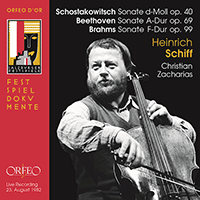Heinrich Schiff
Heinrich Schiff started his musical activities at the age of six on the recorder and piano, taking up the cello at nine. He studied with Tobias Kühne in Vienna until he was twenty-two, subsequently spending three years with André Navarra in Detmold. He recalls Navarra’s finely-detailed approach to nuances of bowing which he said came from the fingertips: ‘the last link in the chain between body and sound, the refiners’. Schiff made his Vienna and London débuts in 1971 and a year later deputised for an indisposed Rostropovich in the Lutosławski Cello Concerto at the ISCM Music Festival in Graz, Austria—an event that accelerated his development as an internationally-known soloist. As a teacher he has worked at the Basle Conservatory, the Salzburg Mozarteum and the Vienna University of Music and Dramatic Arts. In 1982 at the Dartington Summer School he conducted a number of well-received masterclasses which were noted for their intellectual rigour. Schiff’s most well-known pupils include Quirine Viersen, who describes him as ‘very open-minded […] always interested in learning more’, and Natalie Clein.
Playing variously a 1715 Joseph Guarnerius cello (now in Viersen’s possession), the ‘Mara’ Stradivarius of 1711 and the 1739 ‘Sleeping Beauty’ by Montagnana, Schiff has made a number of important recordings including the Shostakovich cello concertos (which won a Grand Prix du Disque) and the Brahms Double Concerto with Frank Peter Zimmermann and Wolfgang Sawallisch (which won the Deutscher Schallplattenpreis). Schiff is the dedicatee of a number of works, including music by John Casken and Friedrich Cerha. His performing career involves solo and chamber playing, and more latterly (having studied with Hans Swarovsky) conducting. He admits a certain obsession with conducting and, indeed, teaching—both activities he describes as arising from ‘a feeling, even a need, to be part of the […] process’.
Schiff’s playing on record indicates an intelligent and responsive interpreter, adapting his style noticeably according to repertoire. In this sense he might be held up as an exemplar of the twenty-first century’s performance ethos: dealing with the inevitable eclecticism visited upon modern players with an instinctively differentiated approach, underpinned by research and careful scrutiny of context. Thus his Bach C major Suite (1984) is beautifully shaped with clean tone, suggesting a scholarly appraisal of historical performing styles to support an appreciation of these movements as dances. The Beethoven Triple Concerto (also 1984) sounds more or less as one might expect in a modern mainstream rendition, albeit enriched by some fastidious small-scale phrasing and a thoughtful slow movement. The Elgar Cello Concerto (2003) is performed in an equally conscientious way, with a highly resonant tone and considered, steady tempi implying a great deal of care for this often misunderstood music. Lachner’s 6 Deutsche Tanzweisen (1982) are admirably declaimed, with warmth, humour and a certain logic to the phrasing, confirming that present-day players can be just as communicative as their forebears. In contemporary repertoire, Friedhelm Döhl’s Cello Symphony of 1981 (recorded 2010) is performed confidently, Schiff’s tone being entirely commensurate with the often dark and expansive, yet frequently fragmented, modernist musical textures.
© Naxos Rights International Ltd. — David Milsom (A–Z of String Players, Naxos 8.558081-84)

















